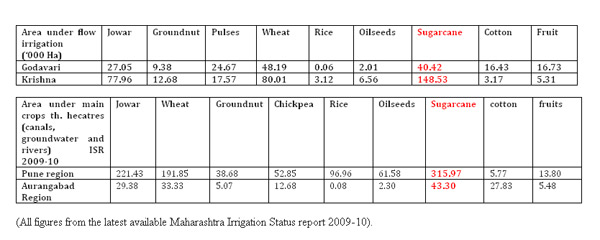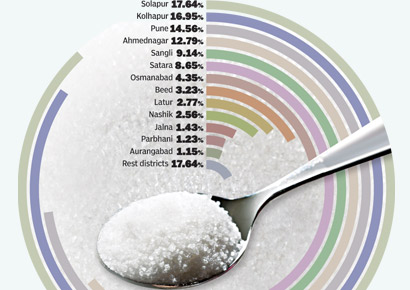
Srijana Mitra Das Apr 3, 2013, 12.00AM IST
The ongoing drought in Maharashtra is being described as the state's worst in many decades, causing agricultural distress and forcing villagers to move to urban areas looking for work. Vandana Shiva, environmental activist and an authority on biodiversity, spoke with Srijana Mitra Das about factors driving this drought, its impact and how it can be contained:
What is the scale of Maharashtra's drought and who's been worst hit?
Large parts of Maharashtra lie in the rain-shadow of the Western Ghats. It is therefore a drought-prone area geographically. But drought vulnerability can be reduced or increased according to how we use land and water. This year`s drought has been described as worse than the 1972 drought yet, if you look at rainfall, 1972`s figures are worse than those of 2012 in most districts.
Today, some of the worst affected districts are Solapur, Pune, Ahmednagar, Sangli, Satara, Osmanabad, Beed, Latur, Nashik, Jalna, Parbhani and Aurangabad — these are also districts where sugarcane cultivation is concentrated.
Is such intensive cash-cropping a cause?
Well, in 1982, i was invited by the Planning Commission to study why, in spite of spending huge amounts on Maharashtra`s water crisis, the problem did not go away. I travelled across the state and researched water use. When Maharashtra needed additional money to deepen wells during its 1972 drought, the World Bank put a condition that Maharashtra would replace its drought-resistant millet crops with sugarcane and its shallow open wells with tube-wells.
Maharashtra receives about 600 mm of rainfall of which only 10% recharges groundwater. That means only 60 mm water is available annually for sustainable water withdrawal — sugarcane needs more than 1,200 mm. Growing sugarcane in drought-prone areas is a recipe for water famine. Yet, the area under sugarcane cultivation in Maharashtra has gone up from 1,67,000 ha in 1970-71 to 10,22,000 ha in 2011-12.
Now, Maharashtra is also growing grapes for export while the cultivation of monocultures of Bt cotton is also making the soil more vulnerable to drought by killing micro-organisms that build the soil`s water-holding capacity. In addition, Maharashtra also has the largest number of dams which have failed to reduce drought vulnerability.
What will the impact of this drought be and is it likely to spread?
If non-sustainable land and water use continue, the drought will spread even when rainfall is normal. The most vulnerable immediately are the poor who will be forced to migrate as environmental refugees. Agrarian distress and farmers` suicides will increase because farmers have spent huge amounts on costly seeds and chemicals a crop failure will make the debt trap a death trap.
What are possible corrective measures?
In a drought-prone area, water harvesting is the answer not water mining. The tank systems of the Deccan are an example of how to create insurance against droughts. Maharashtra needs to harvest its rain, not mine its groundwater and reroute its rivers to rich sugar barons and now, grape barons.
The soil is the largest water reservoir. To hold moisture in the soil, we need to add organic matter. This is why organic farming is vital for drought-prone areas. Millets are suited to Maharashtra`s soil, water and food culture. A wrong transition was made to sugarcane and Bt cotton. This needs to be corrected with a transition to water-prudent crops like millets and mixes with pulses and oilseeds. That`s what we do in Navdanya, the network of organic producers and seed-keepers across several states and it works.
Krishna, Godavari basins drying up
Monday, Mar 18, 2013, 11:08 IST | Place: Mumbai |
Yogesh Pawar
DNA has found out how sugarcane irrigation is drying up the Krishna and Godavari basins. So much so, it now commands maximum irrigation water in the state!

Since a South Asia Network on Dams, Rivers and People (SANDRP) study showed largest amount of water-intensive sugarcane is grown in the most chronic drought-hit Solapur region which also receives the maximum central drought aid, DNA has found how sugarcane irrigation is drying drought-affected Krishna and Godavari basins too. So much so, it now commands maximum irrigation water in the state! (See tables)
Though leading agronomic experts, organisations and reports by institutions like World Bank have often highlighted the unjustifiably high share of sugarcane in Maharashtra’s irrigation, in a cruel irony, a memorandum for drought relief sent to the Centre from Maharashtra in 2003-04 justifies this calling the water-sapping cane “the state’s agro-economic lifeline.”
Parineeta Dandekar of the SANDRP told DNA, “More than agro-economy, sugarcane is currently the lifeline of political economy. Sugar barons who treat constituencies like personal fiefs don’t want to think beyond personal short term profits.”
Scoffing at official claims of three million farmers plus labourers are involved in sugarcane farming, Dandekar asks, “Even if a million ha were under sugarcane, how can three million be involved in sugarcane farming when average farm size in Maharashtra is 1.45 ha?”
“Instead of hiding behind dubious statistics, politicians should ensure farmers don’t suffer the same fate repeatedly. Climate change means droughts are more frequent. The only way out is to improve resilience of agro-economic and water management systems. Encouraging sugarcane in chronically drought affected areas is poor adaptation and pushes dependent farmers further into the vicious cycle of uncertainty, drought, crop failures, and hardships.”
Others point out how sugar-baron politicians obstruct district collectors from exercising their power to reserve water for drinking in any project.
For instance Osmanabad collector KM Nagzode wrote to the state sugar commissioner on 29 November 2012 that his district had received only 50% of average rainfall, and water levels in dams were extremely low while ground water hadn’t been replenished. “Since a sugar factory uses at least a lakh litres of water daily, it’d be advisable to suspend crushing and divert harvest to neighbouring districts.” However such orders were never given and cane crushing went on.
With over 25,100 hectares under it, the arid Osmanabad is a major sugarcane producer thanks to it getting all the irrigation.
This year Maharashtra had sought Rs2,500 crores for drought relief. The Centre has agreed to less than half the amount (Rs1,207 crore) on March 12. “Yet, one can imagine politicians and ministers salivating over siphoning money under EGS, tankers and cattle camps or still fancier ones like water trains. With the first rain, they’ll be back to aggressively plugging sugarcane,” laments a senior state water resources bureaucrat. “It took very long for Anna Hazare and Popatrao Pawar to eradicate the sugarcane scourge from their own villages of Ralegan Sidhi and Hiware Bazar. Wonder who will do this for the remaining state?”
Explaining why sugarcane is attractive he added, “Unlike other crops, cane merely requires switching on the pump to flood fields. Also given how politicians bend over backwards in increasing procurement price every year makes it more and more attractive.”
According to him it will need a tall leader who the farmers trust and believe in to take them away from sugarcane. “The only one who can do it is busy managing cricket. As for the others, I wouldn’t be surprised if they think sugar directly grows in fields,” he lamented with a smile.
Drought-hit Solapur grows water-guzzler cane
Wednesday, Mar 13, 2013, 8:30 IST | Place: Mumbai
Yogesh Pawar
Sugarcane, the most water-intensive crop grown in Maharashtra, requires 10 times more water than jowar or groundnut.
Sugarcane, the most water-intensive crop grown in Maharashtra, requires 10 times more water than jowar or groundnut. Yet the regions it is grown in most are chronically drought-hit, and receive highest central aid for drought relief. What’s worse a dismally low amount of sugarcane area under drip irrigation. These findings of a latest study by South Asia Network on Dams, Rivers and People (SANDRP) come at a juncture when CM Prithviraj Chauhan has officially admitted “11,801 villages are in the grip of a drought worse than 1972.” More than 50% of these are in Solapur district alone.
The study slams the government for agro policies points out how the current drought and the hardships it brings in its wake are being compounded by politicians from the sugar lobby.
“The drought hasn’t exactly crept in by stealth. It’s building since August 2012, when over 400 villages were officially declared drought-hit,” observed Parineeta Dandekar of SANDRP who has conducted the study. ““The sugarcane farmers’ protest over fair price was boiling for past few years and the government kept ignoring warnings about the irrigation scam, despite its unprecedented scale in the same period.”
According to the study all these factors have not come together in a mere unfortunate coincidence. ““It makes reasons behind Maharashtra’s drought starker than poor rainfall. Unless addressed, no amount of state and central assistance can reduce the misery of the people struggling with drought.”
The study points out how In 2009-10, of the approximate 25 lakh hectares (ha) of irrigated area in Maharashtra 3,97,000 ha was under sugarcane. Area under sugarcane grew to 9,70,000 ha in 2010-11 and then to 10,02, 000 ha by 2011-12. “When grown on 16% irrigated area, sugarcane used 76% of all water available for irrigation. With increasing area under sugarcane, its hegemony has increased exponentially. Not only does it capture maximum water, it results in water logging, salinity and severe water pollution by sugar factories,” it says. Incidentally, at 209 Maharashtra has the largest number of sugar factories in India.
The study uses Solapur district in Bhima basin to connect drought with sugarcane. Here drinking water supply is already a severe problem. Despite over a 1,000 tankers being pressed into service, an exodus of stricken communities to urban areas has begun. Though chronically drought-hit, this worst drought-hit district in the country has the largest areas in any single district growing sugarcane (vis-a-vis size) according to the new study.
With an average rainfall of 550 mm Solapur is the largest sugarcane producer in the state and has densest concentration of both area under sugarcane (see pie chart above) and sugar factories. The district includes Union agriculture minister Sharad Pawar’s parliamentary constituency too. “That such water-intensive cropping should flourish in an arid region in Pawar’s own constituency talks a lot about both political power of sugarcane and the attitude of the ministry,” remarks the study.
The study shows how several sugar factories upstream of Ujani, take water through unauthorised lifts from the backwaters and places total water going to sugarcane from the dam to be over 80%. “This causes severe water scarcity downstream, and Solapur faces the brunt of drought,” it observes and adds, “This diversion can’t happen without political support. Of the 30 cabinet ministers in the state, 13 either own sugar factories, or substantial shares in them.”
Pointing out the irony of the state’s recent white paper on irrigation projects which boasts that Ujani irrigates 92,000 ha of sugarcane, the study asks how such shocking usage can be justified in a drought-prone, acutely low rainfall region.
When approached for comment Solapur Collector Pravin Gedam told DNA that he had already communicated the concerns of district administration to state authorities. “We have already exhausted 17% of the dead water so obviously we are concerned. We are rationing out whatever if left so that we can go on till the monsoon,” he said and added, “We raid and confiscate pumps whenever we hear of illegal lifting of water upstream.”
Source: DNA
http://www.dnaindia.com/mumbai/1809327/report-drought-hit-solapur-grows-water-guzzler-cane




